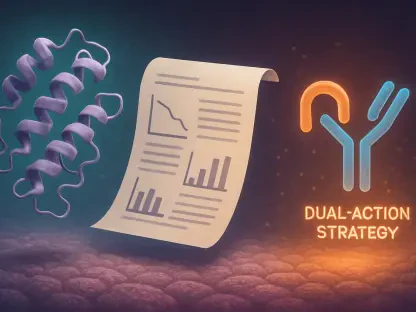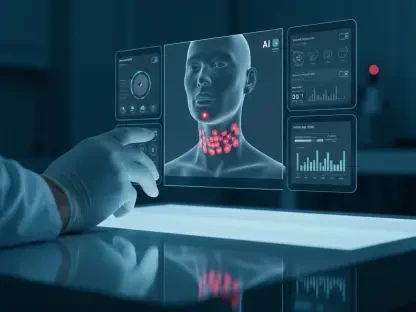In a world where technology increasingly intersects with human cognitive abilities, Ivan Kairatov, a renowned figure in biopharma and innovation, shares insights into a groundbreaking development. His team’s research on a home-based, AI-powered brain stimulation system aims to enhance concentration through personalized, non-invasive methods. This initiative, as detailed in npj Digital Medicine, could transform educational, clinical, and training sectors, making cognitive enhancement more accessible. In this interview, Kairatov delves into the motivations, mechanics, and potential future of this cutting-edge technology.
What motivated the development of a personalized brain stimulation system using AI?
The main motivation was the increasing demand for tools that can help individuals enhance their cognitive performance, especially in our distraction-filled modern world. We wanted to create a system that anyone could use from home, allowing for privacy and convenience while still providing powerful enhancements to one’s concentration and mental capabilities. By incorporating AI, we saw an opportunity to tailor the experience to each unique user, making it far more effective than one-size-fits-all approaches.
Can you explain how the technology adapts to individual characteristics to enhance concentration?
Our technology uses AI algorithms to analyze various personal features, such as attention levels and even physical attributes like head size. With these insights, the system can adjust the brain stimulation parameters to fit each individual. This adaptive nature ensures that users receive the most effective stimulation for their specific needs, optimizing their concentration and performance.
How does transcranial random noise stimulation (tRNS) work, and why was it chosen for this system?
Transcranial random noise stimulation works by applying a gentle, randomized electrical current to the scalp, which influences brain activity. We chose tRNS because it is non-invasive, painless, and has been shown to effectively enhance cognitive functions without adverse effects. Its randomness helps in mitigating adaptation in the brain, maintaining stimulation effectivity over time.
In what way does the AI algorithm personalize the brain stimulation for different users?
The AI algorithm learns from the user’s performance data and continuously adjusts the settings. It determines the optimal intensity and pattern of the stimulation based on individual characteristics and real-time feedback. This makes the stimulation more effective by honing in on what works best for each person, avoiding the need for generic, less effective treatments.
Could you elaborate on how the AI tailors stimulation intensity without needing expensive MRI scans?
AI uses a combination of data inputs gathered from user interactions and physiological markers linked to their concentration levels. This enables it to estimate the required stimulation intensity by tracking changes and improvements in cognitive performance. By doing so, it bypasses the traditional need for expensive and less accessible MRI scans, making the system more practical for everyday users.
What was the process involved in training the AI, and what criteria were used to select the 103 participants?
The AI was trained using data from 103 individuals who participated in regular home-based sessions. These sessions involved a task designed to measure sustained attention, an area we aimed to enhance. Participants were chosen across various backgrounds to ensure a diverse set of data points, focusing on ages 18 to 35—a demographic where cognitive focus is often crucial for work and study.
How was the effectiveness of the system evaluated in the double-blind study with 37 participants?
In the study, we observed the performance of participants receiving personalized AI-guided stimulation against those with standard and placebo treatment. Improvements in concentration and task performance were quantitively assessed, demonstrating that personalized stimulation offered significant benefits over other methods.
What improvements in performance were observed in participants using AI-guided stimulation compared to standard or placebo?
Participants using AI-guided stimulation showed marked improvements in sustained attention and overall task performance. The most significant benefits were noted among individuals who initially had lower concentration levels, suggesting the personalization aspect truly made a difference where it was needed most.
Are there specific characteristics or initial conditions that make some people benefit more from this system?
Yes, individuals with lower initial attention levels tend to benefit the most. This system is particularly effective for those who struggle with focus under normal conditions, as the personalized stimulation can target and enhance their cognitive abilities more profoundly than it might for those who already have strong concentration skills.
How did the study ensure that the brain stimulation was both safe and effective?
Safety was a top priority in developing this system. Extensive testing and validation were conducted, including a double-blind study designed to rule out placebo effects and confirm the safety and efficacy of the stimulation. We made sure that the technology adheres to existing safety standards and continuously monitored participants for any adverse reactions.
Were there any side effects observed, and how did they compare to the placebo group experiences?
No serious side effects were reported during the study. Any sensations felt during stimulation were comparable to those reported by the placebo group, indicating that the experience of stimulation was similar in physical perception, with no additional discomfort or negative impacts.
What potential does this system hold for applications in fields like education, training, and clinical use?
The system has immense potential across numerous fields. In education and training, it can be used to assist students and professionals in enhancing their focus and learning abilities. Clinically, it might be employed to help individuals with attention deficits or cognitive impairments, providing a personalized and adaptive treatment option.
How do you envision the role of AI and wearable neurotechnology evolving in the future?
AI and wearable neurotechnology are poised to revolutionize how we interact with cognitive enhancement tools. As these technologies evolve, they will become even more integrated into daily life, offering continuous, real-time enhancement tailored to individual needs. This progress will likely lead to smarter, more efficient, and even more user-friendly systems.
Can you discuss the scalability and accessibility of this brain stimulation system for the general public?
We’ve designed the system to be highly scalable and accessible. By eliminating the need for expensive equipment like MRI machines, and focusing on wearable technology that pairs with existing consumer electronics, we’ve lowered barriers to entry. Our goal is to ensure that anyone who could benefit from enhanced cognitive performance can access these tools regardless of their location or financial status.
How might this technology influence our ability to enhance cognitive performance in a modern, distraction-filled world?
This technology promises to be a game-changer. In an era where distractions are ubiquitous, having a tool that can sharpen focus and enhance cognitive ability provides a critical advantage. It empowers individuals to regain control over their mental faculties, boosting productivity, learning capabilities, and even overall cognitive health in an increasingly complex and technologically driven world.
What challenges did you face in the development and testing phases of this personalized stimulation system?
One of the main challenges was ensuring the system was truly personalized without being cumbersome for the end-user. Balancing complexity with user-friendly design required innovative approaches in both hardware and AI algorithm development. Testing was also rigorous as we needed to validate efficacy and safety concurrently, which involved extensive iterative processes and multiple layers of validation.
What ethical considerations do you think are important when using AI in neurotechnology?
Ethical considerations are crucial in this field. Ensuring user data privacy and avoiding unintended manipulation or adverse psychological effects must be prioritized. Additionally, it’s important to bridge the gap between accessibility and exclusivity, ensuring that these technologies do not become tools that only benefit a select few but are available to a wide audience fairly and responsibly.









